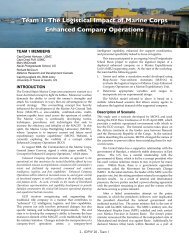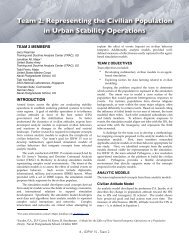pdf file - SEED Center for Data Farming - Naval Postgraduate School
pdf file - SEED Center for Data Farming - Naval Postgraduate School
pdf file - SEED Center for Data Farming - Naval Postgraduate School
Create successful ePaper yourself
Turn your PDF publications into a flip-book with our unique Google optimized e-Paper software.
Figure 2: Patrol being ambushed by insurgents<br />
o available sensor system: normal human viewing<br />
and /or infrared<br />
o available effector system: 7,62mm machine gun,<br />
heavy machine gun<br />
o rules of engagement: from "defense only" vs. "fire<br />
as soon as insurgents were identified"<br />
o Dingo kill probability when being hit by an RPG:<br />
50% vs. 75%<br />
o deployment of the UAV LUNA <strong>for</strong> advance<br />
airborne reconnaissance of the patrol route<br />
• Red <strong>for</strong>ces variation:<br />
o number and position of insurgents: three different<br />
ambush situations<br />
o available effector<br />
systems: AK47,<br />
RPG7, heavy<br />
machine gun<br />
o patrol vehicle that<br />
gets struck by IED<br />
(position within<br />
the patrol)<br />
• Weather: clear sky /<br />
cloudy weather /<br />
strong fog<br />
As MoEs we were<br />
mainly looking at damages<br />
and losses of the blue and red<br />
<strong>for</strong>ces.<br />
All of our experiments<br />
were successfully executed<br />
on the new 520-node German<br />
cluster owned by the German<br />
Procurement Office (BWB).<br />
In an iterative approach we were<br />
executing several data farming<br />
experiments to analyze the<br />
mentioned parameters' influence<br />
on the overall mission success, i.e.<br />
avoiding blue losses. The final<br />
experiment encompassed 64800<br />
simulation runs, successfully<br />
executed on the 520 cluster nodes<br />
in only 6 hours.<br />
<strong>Data</strong> <strong>Farming</strong> Results<br />
For the analyzed ambush<br />
situations, the red <strong>for</strong>ces benefit a<br />
lot from bad weather conditions.<br />
In case there is strong fog, the<br />
insurgents lying in ambush and<br />
being concealed by small bushes<br />
and trees can hardly be detected,<br />
neither by the patrol itself nor by<br />
the LUNA reconnoitering the area<br />
in advance. As a result, many blue<br />
vehicles were severely damaged<br />
but only a few insurgents got<br />
killed.<br />
For that reason we decreased the amount of data to be<br />
analyzed by only looking at the scenarios with good weather<br />
conditions.<br />
In those cases, the type of ambush setup by the<br />
insurgents was the most influencing factor regarding blue<br />
kills, followed by the patrol vehicle distance (see Figure 3).<br />
In ambush scenario 1, there is only one group of six<br />
insurgents south of the patrol route. They are very well<br />
hidden and camouflaged within bushes.<br />
In ambush scenario 2, two additional groups of six<br />
insurgents are hiding behind walls and buildings north of the<br />
patrol route. They move out of their hiding places towards the<br />
patrol as soon as the IED detonates.<br />
Figure 3: Regression tree <strong>for</strong> the number of blue <strong>for</strong>ces destroyed<br />
15 - IDFW 20 - Team 4




